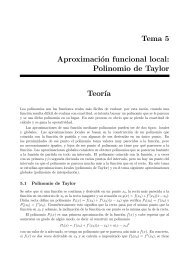Cap´ıtulo 1 Aplicaciones de la integral
Cap´ıtulo 1 Aplicaciones de la integral
Cap´ıtulo 1 Aplicaciones de la integral
You also want an ePaper? Increase the reach of your titles
YUMPU automatically turns print PDFs into web optimized ePapers that Google loves.
Javier Martínez <strong>de</strong>l Castillo <strong>Aplicaciones</strong> <strong>de</strong> <strong>la</strong> <strong>integral</strong> 2<br />
Hal<strong>la</strong>r el área <strong>de</strong> <strong>la</strong> región limitada por <strong>la</strong> curva y = x 3 − 3x 2 − x + 3 y<br />
el eje OXen el intervalo [1, 3].<br />
Hal<strong>la</strong>r el área <strong>de</strong>limitada por <strong>la</strong> gráfica <strong>de</strong> y = cos x y el eje OX, en el<br />
intervalo [0, 2π].<br />
Con escasas modificaciones po<strong>de</strong>mos exten<strong>de</strong>r <strong>la</strong> aplicación <strong>de</strong> <strong>la</strong> <strong>integral</strong><br />
<strong>de</strong>finida para cubrir no sólo el área <strong>de</strong> <strong>la</strong> región bajo una curva, sino el <strong>de</strong><br />
una región comprendida entre dos curvas. Por tanto, obtenemos el siguiente<br />
resultado :<br />
Teorema (Área <strong>de</strong> una región entre dos curvas): Si f y g son<br />
funciones continuas en [a,b] y se verifica que g(x) f(x) ∀x ∈ [a,b],<br />
entonces el área <strong>de</strong> <strong>la</strong> región limitada por <strong>la</strong>s gráficas <strong>de</strong> f y g, y <strong>la</strong>s rectas<br />
verticales x = a y x = b, es :<br />
Observaciones:<br />
A =<br />
b<br />
[f(x) − g(x)] dx ν<br />
a<br />
Es importante darse cuenta <strong>de</strong> que <strong>la</strong> vali<strong>de</strong>z <strong>de</strong> <strong>la</strong> fórmu<strong>la</strong> <strong>de</strong>l área<br />
<strong>de</strong>pen<strong>de</strong> sólo <strong>de</strong> que f y g sean continuas y <strong>de</strong> que g(x) f(x).<br />
Las gráficas <strong>de</strong> f y g pue<strong>de</strong>n estar situadas <strong>de</strong> cualquier manera respecto<br />
<strong>de</strong>l ejeOX.<br />
Si, cómo suele ocurrir, unas veces se cumple que g(x) f(x) y otras<br />
veces que f(x) g(x), entonces el área <strong>de</strong> <strong>la</strong> región comprendida entre f y<br />
g sobre el intervalo [a,b], viene dado por <strong>la</strong> fórmu<strong>la</strong>:<br />
A =<br />
b<br />
a<br />
| f(x) − g(x) | dx ,<br />
En <strong>la</strong> práctica, no se suele trabajar con el valor absoluto, puesto es más<br />
fácil dibujar <strong>la</strong>s gráficas <strong>de</strong> f y g, calcu<strong>la</strong>ndo los puntos <strong>de</strong> intersección <strong>de</strong><br />
ambas, y sumar una o más <strong>integral</strong>es para obtener el área <strong>de</strong>seada.<br />
Ejemplo 2:<br />
Hal<strong>la</strong>r el área <strong>de</strong> <strong>la</strong> región limitada por f(x) = x 2 y g(x) = √ x.<br />
Hal<strong>la</strong>r el área <strong>de</strong> <strong>la</strong> región limitada por f(x) = x 2 y g(x) = x 3 .




